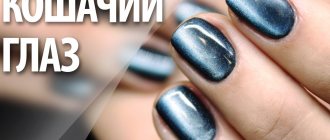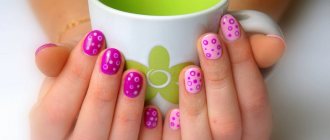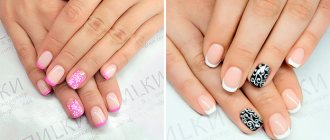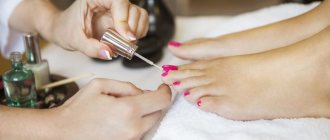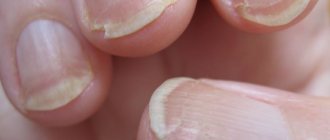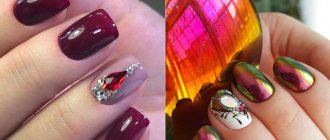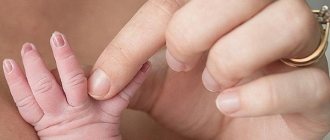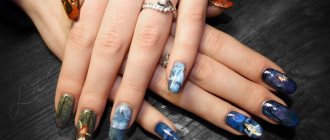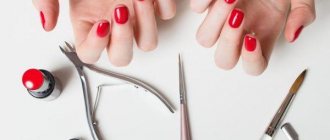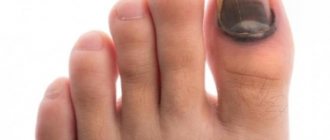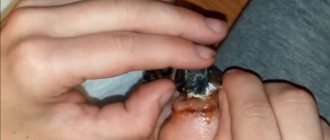White stripes on nails are not only a cosmetic imperfection. Such a symptom may indicate the development of disorders in the body: deficiency conditions, dysfunction of the gastrointestinal tract. To find out the root cause of the disorder, it is recommended to consult a doctor. The specialist will prescribe a comprehensive examination and, according to its results, select the appropriate treatment regimen. Self-medication is not recommended, as it may not provide the desired therapeutic result and cause complications. Any medications, vitamin complexes and dietary supplements can be used only after confirmation of a deficiency of a particular substance. Therapeutic nail polishes and oils affect the problem externally and are not able to eliminate the root cause of the problem.
Causes
Leukonychia is the medical name for white stripes and spots on the nail plates. A common symptom that every person has encountered at least once in their life. It can be either a cosmetic imperfection or a sign of a systemic disease. Healthy, undamaged nails have a translucent structure through which the skin is visible. This gives healthy nails a pinkish tint. In some cases, a white stripe or spot forms between the nail bed and the plates, which may increase in size over time or disappear completely.
The effects of exogenous and endogenous factors are distinguished, which can provoke the formation of white stripes on the nail plates. Among the systemic disorders that can lead to leukonychia are the effects of:
- iron deficiency anemia
- skin diseases: psoriasis, dermatitis
- fungal nail infection
- lack of minerals (zinc, copper, calcium)
- diseases of the urinary system
- cardiovascular disorders
- diseases affecting liver cells and hepatocytes: hepatitis, cirrhosis
- diseases of the thyroid gland: hypo-, hyperthyroidism, autoimmune thyroiditis
Often white stripes on the nails are observed in people with digestive disorders and dysfunction of the gastrointestinal tract.
Important! Conditions when damage to several or all nail plates on the hands and feet require special attention.
Choose a specialist, read reviews and make an appointment with a dermatologist online
Deficiency of micro and macronutrients
A deficiency of vital vitamins, minerals, amino acids, and protein negatively affects biochemical parameters and leads to deterioration of the condition of the skin, hair, and nails. Often this condition is accompanied by accompanying symptoms:
- general weakness
- increased fatigue
- pale skin
- peeling skin
- wounds and cracks in the corners of the lips
- stomatitis
- decreased visual acuity
Deficiency states can be caused by both poor-quality nutrition and disruption of the gastrointestinal tract, prolonged systemic inflammation. Without eliminating the root cause of the disorder, taking vitamin and mineral complexes may be ineffective. The situation gets worse if a person is under stress: a large white spot forms in the center of the nail plate, which does not go away for a long time.
Fungal infection
Fungal infections, however, are one of the main reasons for changes in the appearance of the nail plates. Accompanied by the formation of white spots and stripes, discoloration and thickening of nails, increased fragility. It is important to understand that fungus is a systemic infection that requires long-term, systematic therapy. External means of traditional and folk medicine can only temporarily correct the disorder. Nail mycosis is recommended to be treated under the supervision of an experienced dermatologist or infectious disease specialist. At the same time, it is important to normalize the immune status and monitor the diet.
Infectious diseases
Infectious pathologies can also lead to depletion of vitamins and minerals in the body, cause deficiency conditions, and decreased immunity. This negatively affects the condition of the nails: white longitudinal stripes form, the plates become fragile and brittle. It is important to find and eliminate the primary source of infection, after which you can begin to replenish deficient conditions. The earlier treatment begins, the better the prognosis.
Poor nutrition
Poor nutrition, strict diets, an abundance of simple carbohydrates in the diet. The lack of fiber and healthy fats leads to exhaustion of the body, nutritional deficiencies and the formation of white spots on the nails. If poor quality nutrition is combined with malabsorption syndrome - a malabsorption of nutrients in the intestine, the situation gets worse. Prolonged deficiency of vital substances in combination with mitochondrial dysfunction can provoke serious metabolic disorders, including cancer.
The diet must contain high-quality, easily digestible protein, fiber, healthy fats, and whole grain cereals. Modern food products do not contain the daily required amount of all nutrients. Therefore, it is advisable to consult a doctor for the selection of a high-quality, suitable vitamin and mineral complex.
Dysfunction of the cardiovascular system
The formation of white stripes and spots on the nails is observed in patients with cardiovascular diseases. This symptom can occur against the background of electrolyte disturbances, mineral imbalance, due to a lack of potassium, magnesium, zinc and other vital substances for the normal conduction and functioning of the heart and blood vessels.
If the following alarming signs are associated with leukonychia, you should immediately consult a cardiologist:
- dyspnea
- chest pain
- tingling heart
- arrhythmia
- blood pressure fluctuations
- increased fatigue
- intense sweating
- sense of anxiety
The doctor will prescribe an electrocardiogram, ultrasound of the heart, and laboratory tests. This will help clarify the diagnosis and begin appropriate treatment.
Oncological diseases
Oncological pathologies are accompanied by systemic and metabolic disorders, mitochondrial dysfunction, and general exhaustion of the body. A deficiency of useful, vital substances, as well as active inflammatory processes, negatively affect a person’s appearance, including skin, hair and nails.
Important! The formation of white spots and stripes is not a specific symptom of cancer, but requires close attention to the state of health.
Neoplasms may not show any additional symptoms for a long time, until the tumor process extensively grows and spreads to surrounding tissues. Therefore, you should not ignore the first alarm bells and immediately seek quality medical care.
Taking medications
Some groups of medications can cause unwanted side reactions in the form of white stripes and spots on the nail plates:
- sulfonamides - antibiotics to treat bacterial infections
- drugs for chemotherapy
- vaccines and medicines that contain heavy metals: ash, aluminum, arsenic
The described substances lead to the development of transverse white stripes on the nail plates. The symptom may go away on its own after stopping the use of medications.
Traumatic lesions
Often the formation of white spots and stripes is associated with traumatic damage to the nail plates. In this case, damage to the matrix layer from which the plate grows is observed.
The violation may be due to:
- bad habit of biting nails
- receiving an accidental blow: being pinched by a door, when hammering nails
- too frequent visits to beauty salons and performing traumatic manicures
- Wearing tight, constricting shoes - may cause white streaks and spots on the toenails
If the symptom is caused by traumatic lesions, then rounded spots and stripes will be spread over the entire surface of the plate. They will move towards the edge as the nail grows and eventually disappear completely.
Hereditary predisposition
Often the formation of stripes and spots can be associated with a genetic predisposition to such manifestations. In this case, the formation of white spots does not pose a threat to life and specific therapy is not required in most cases. Spots and stripes can form and go away on their own, depending on endogenous and exogenous factors.
Diabetes
In patients with diabetes mellitus, metabolic disorders progress, an imbalance of beneficial micro and macronutrients, fat-soluble vitamins occurs, the absorption of fats and the flow of glucose into cells are disrupted. All this can negatively affect the condition of the nails, often leading to the formation of white stripes. In this case, it is necessary to monitor glucose, insulin, and glycated hemoglobin levels. As the metabolic disorder enters a phase of stable remission, all external manifestations of the disease will pass.
Parasitic infections
The condition of the nail plates can indicate numerous disorders of the internal organs, including helminthic infestation. Particular attention should be paid to the nail plates, on which small-diameter but deep dots-dents, white stripes, and indentations form. In most cases, such symptoms are observed in children and are accompanied by:
- digestive disorders
- weight loss
- lack of appetite
- defecation disorder
- nausea
- vomiting
- headache
- with extensive infestation, mucus impurities are observed in the stool, as well as copious mucous discharge from the nose
Parasites are the most ancient representatives of the human flora and over thousands of years they have learned to masterfully hide from the cells of the immune system. This is why identifying worms is often difficult. Infectious disease doctors recommend diagnosing during the full moon, when active laying of parasite eggs begins. The day before, drugs are used to provoke the death of worms, after which they begin the search. It is necessary to take a stool and blood test.
Exposure to chemicals
With prolonged use of low-quality nail care products: polish, nail remover, plates begin to dry out and white streaks form on them. Most cosmetic products contain formaldehyde and a large number of other toxic substances that negatively affect not only the appearance of nails, but also their overall health.
As an alternative, it is recommended to abandon the use of varnishes and gel polishes, and strengthen nails using natural remedies: high-quality vegetable and essential oils, sea salt-based baths. It is also important to replenish the deficiency of essential substances in the body and direct efforts towards the treatment of chronic diseases.
Thyroid dysfunction
A decrease or increase in the activity of the thyroid gland affects the functioning of the entire body. The gland is responsible for the production of hormones and for its normal functioning it requires a sufficient amount of iron, iodine, zinc, selenium, vitamins A and D, group B, folic acid. A decrease in the activity of the thyroid gland leads to brittle hair and nails, dry skin, apathy, a feeling of constant fatigue, a significant decrease in performance, and intolerance to cold.
Reasons for the appearance of white stripes
Leukonychia can be divided into two types: true and false. In the first case, white stripes appear due to disturbances in the nail matrix. But often a person has false leukonychia, which is caused by certain disorders or diseases. If white stripes appear on your nails, then you should visit a doctor and undergo a comprehensive examination. It is very important to find the cause of these changes .
The main reason may be a disruption in the process of nail keratization. This may mean that microscopic air layers have formed under the layers of water and lipids, which is exactly what we see under the nail of the thumb and the rest in the form of dashes and spots. In fact, keratinized tissues lack white pigment.
There are two types of leukonychia based on their prevalence. In the case of a limited process, partial disruption of keratinization may appear on several fingers. And with a total process, all nails are affected.
The causes of false leukonychia can be very different:
- hypervitaminosis and hypovitaminosis;
- lack of minerals, amino acids;
- heart failure;
- anemia;
- pathologies of the gastrointestinal tract (colitis, dysbacteriosis, enteritis);
- fungal diseases;
- mechanical damage;
- impaired metabolism;
- hormonal imbalances;
- liver and kidney damage;
- frequent stress, poor nervous system;
- diabetes.
Which doctor should I contact?
At the first alarming symptoms: the formation of white stripes and spots on the nails, it is recommended to consult a dermatologist. In the future, concomitant consultation with a trichologist, infectious disease specialist, cardiologist, endocrinologist, gynecologist, nutritionist, and dietician may be required. In some situations, complex treatment with the help of doctors of several specialties is required. To achieve the best therapeutic result, you must adhere to the recommendations of specialists and refrain from self-medication.
Choose a specialist, read reviews and make an appointment with a dermatologist online
Treatment options
The course of therapy depends on the cause of leukonychia; based on diagnosis, drug treatment is prescribed.
The following drugs can be used for this:
- Nizoral, Clotrimazole (antifungals).
- Vitamins A, B (general strengthening).
- Afabazol, Novo-passit (sedative).
- Karsil, Essentiale (homeopathy to restore liver function).
Along with this, the doctor may prescribe a vitamin complex and diet.
The white stripes themselves do not cause discomfort; the only concern is their appearance.
There are several ways to fix this problem:
- Treatment of the nail plate. This method is a careful hardware stripping of the nail. To do this, it is better to use the services of a specialist in a nail salon. If the grooves on the plate are shallow, then this defect can be easily removed.
- Paraffin therapy. The procedure is similar to a manicure, but the varnish is replaced with cosmetic paraffin. It is applied to the cleaned surface. Nails are enriched with vitamins and promote healing.
If the disease is in an advanced form, doctors prescribe surgical treatment. Chemical nail removal is most often used. Before the procedure, the top layer of the nail is removed, the skin around the nail must be covered with a plaster so as not to damage it. A bandage with medications is applied to the affected area for 2-3 days, after which it is removed and the softened areas are removed.
Diagnostics
To confirm the diagnosis, the doctor conducts a face-to-face examination and oral questioning of the patient, collects anamnesis, including family history. Questions the patient about what medications he took previously, what infectious diseases he suffered, and whether he suffers from any chronic pathologies. Next, they are asked about sleep and nutritional patterns, the presence of bad habits, psycho-emotional state, and possible sources of stress.
Additional studies are prescribed:
- microscopic examination of the nail plates to exclude the fungal nature of the origin of the disorder
- complete blood count
- general urine analysis
- coprogram
- biochemical blood tests: ferritin, zinc, serum iron, copper, vitamin D, lipid profile, TSH, T3, T4, glucose, insulin
- organic acid test
- genetic tests, if necessary
- ultrasonography
If tumor processes or other serious diseases are suspected, additional instrumental research methods are prescribed: magnetic resonance imaging and computed tomography.
Differential diagnosis
Using the differential diagnosis method, you can accurately make a diagnosis by comparing symptoms with possible types of diseases. Barring ineligible diseases, there is only one option left.
It is necessary to differentiate leukonychia from the following pathologies:
- Nail psoriasis. The lesion is characteristically symmetrical. Multiple pinpoint depressions and small psoriatic papules appear on the nail plate.
- Eczema is a chronic disease that affects the nail plate. The main reasons are nervous tension or infection with microbes. Often accompanied by separation of the plate from the nail bed.
- Senile nails are a change in nail color, mainly in old age due to impaired blood microcirculation. As a result of the disease, nails become dull, sometimes gray or even yellow.
- Lichen planus on the nails. Accompanied by rashes on the skin and mucous membranes. Nails become thin, lose their natural color, and begin to peel in the distal area. Cracks and nail dystrophy often appear.
- Follicular dyskeratosis, or Darier's disease. Longitudinal white stripes appear. They are above the level of the nail, and the nail itself begins to break. Sometimes the stratum corneum under the nail becomes excessively large.
- Alopecia areata, in which the lesion also extends to the nails. Dotted depressions, white spots, and sometimes peeling are observed on the nail plate. Changes to the scalp are required.
Treatment
There is no quick way to get rid of white streaks on your nails. Stripes and spots either grow back and go away on their own, or require specific treatment. During therapy, the doctor takes into account the root cause that caused the disorder, as well as the age, gender, individual characteristics of the patient’s body, concomitant pathologies, reaction to medications and vitamin complexes.
General recommendations regarding treatment:
- Identify and compensate for deficiencies of minerals, vitamins, amino acids: take medications only after a thorough examination and as prescribed by a doctor. Twice a year you can take high-quality multivitamin complexes with vitamins and minerals in active, chelated forms.
- Determine the source of chronic infection, which significantly reduces the immune status and provokes complications: the use of antiviral, antifungal, antibacterial agents, immunomodulators.
- For diabetes mellitus, use Metformin, alpha-lipoic acid, taurine, vitamin D, B vitamins in active forms, mineral complexes.
- For diseases of the thyroid gland, you may need to take hormonal medications, as well as iodine, selenium, B vitamins, and iron.
- Helminthic infestations require an integrated approach and long-term, gentle therapy with the help of chemical drugs, as well as herbal preparations.
- Fungal infections require long-term use of antifungal medications for external treatment and internal administration, as well as diet. Sugar, simple carbohydrates, fresh baked goods, and sources of yeast are removed from the diet.
For successful therapy, it is also recommended to limit exposure to toxic substances and avoid using aggressive detergents, varnishes and other cosmetics with unsafe composition. Only a doctor can select an exact treatment regimen; it is recommended to refrain from self-medication.
Provocateurs of longitudinal grooves
Longitudinal stripes on fingernails also occur due to a lack of microelements. Only in this case we are talking about vitamin B12. In older people, such nail changes are signs of age-related changes and often do not mean serious illnesses.
If the nail of any finger was suddenly struck by vertical stripes, then the body could be attacked by ailments such as gout, psoriasis, lichen ruber, or rheumatoid arthritis. Particular attention should be paid to the location of symptoms on the stratum corneum of the hand.
So, with severe emotional shocks, impaired functioning of the central nervous system or damage to the spinal cord, the stripes become narrow and the nail itself becomes flat.
Vertical lines can be multiple or single, but if they protrude strongly above the stratum corneum, then it is worth checking the pancreas and intestines. Symptoms such as the appearance of two parallel stripes along the edges of the nail indicate malfunctions of the heart and blood vessels, and high blood pressure.
Prevention
To prevent the formation of white stripes on nails, you must adhere to the following recommendations:
- monitor the quality of food: reduce sugar, fast carbohydrates, introduce a sufficient amount of fiber, protein, vegetable oils
- Take regular care of your hands and nails
- improve digestion: in case of low acidity, discuss with your doctor the possibility of using betaine and pepsin for normal absorption of vitamins and minerals from food, use enzymes, choleretic drugs
- eliminate metabolic disorders, normalize body weight
- observe safety precautions when performing potentially dangerous, traumatic work
- give up bad habits: smoking, drinking alcohol, overeating
- maintain a drinking regime: the daily norm is calculated using the formula 30 ml multiplied by body weight
- use protective gloves when working with household or industrial chemical cleaning agents
- give preference to moderate physical activity: running, yoga, gymnastics, swimming, daily walking in the fresh air (7000-10000 steps), breathing exercises
- eliminating the source of stress, maintaining a work and rest schedule
- preventive intake of vitamin complexes and dietary supplements selected by a doctor individually
- undergo an annual scheduled basic examination of general health: blood, urine, stool tests, ultrasound diagnostics, for patients with chronic diseases - be under constant medical supervision
All preventive recommendations boil down to adhering to the basic principles of a healthy lifestyle, avoiding negative emotions and significant experiences, moving more, and developing. This has a beneficial effect on physical and psychological well-being, allows you to avoid many somatic diseases, and also significantly improve your appearance, including the condition of your skin, hair and nails. Timely, high-quality therapy of systemic diseases under the supervision of an experienced specialist is also indicated.
White stripes on nails. How to recognize a defect?
Leukonychia is what doctors call the appearance of white longitudinal or transverse stripes on the nails. This defect of the nail plate can be determined visually. The disease first appears as white dots on the fingernails and toenails. Then the white dots take the form of stripes, stretching along or across.
Horizontal or vertical white stripes can appear in both women and men. Women are more attentive to the condition of their nails and therefore more often notice stripes on their nails.
The manifestation of the disease can be different. This may be one single stripe on one of the nails. In addition, leukonychia can appear on all fingers or toes.
What do white stripes on nails mean? The presence of white stripes on the nail plate indicates that you need to undergo treatment or change your diet.
Folk remedies
If for some reason going to the salon is not possible, try using folk remedies.
Baths
Baths made from vegetable and essential oils are considered a good way to eliminate the defect.
To prepare you need:
- Take half a glass of vegetable oil.
- Add 5 drops of bergamot or sandalwood essential oils.
- Heat the mixture in a water bath to a temperature of 37-38 degrees.
Immerse the sore finger in the warm mixture and hold until it cools. Do not wash off the medicinal composition, but rub it into your hands with massage movements.
An iodine-soda bath gives a strengthening and restorative effect.
You will need:
- 1/3 cup warm water.
- 3-4 drops of iodine.
- 2 tsp. sea salt.
- 1 tsp. soda
It is recommended to do these baths twice a day until the structure of the plate is restored.
Massage
Treat the diseased nail with rich cream or oil. Then massage with your thumb in light circular movements, applying light pressure. A feeling of warmth and redness indicates blood flow, after which the massage can be stopped.
Lemon juice
Freshly squeezed lemon juice works well to correct defects. You need to make a lotion from lemon pulp and keep it on your finger for at least 10 minutes. You can apply drops of juice to the plate. It is better to do the procedure before going to bed, as the juice must be absorbed.
Rubbing
Masks are an effective remedy.
For the oil-lemon rub you will need:
- 10 ml olive oil.
- 1 tablespoon lemon juice.
- 3 drops of iodine.
Mix thoroughly and rub into the plate daily. This product will help strengthen your nails and reduce white streaks.
Vitamin-iodine masks help quickly restore the structure of the plate.
To do this you need to make a mixture:
- 1 tsp. almond oil.
- 5 drops of vitamin A.
- 5 drops of iodine.
Mix and rub into nails daily before bed.
